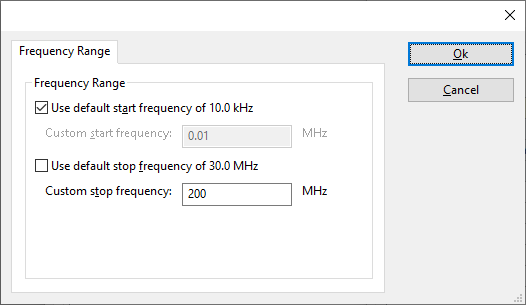Anritsu MS2601A: Difference between revisions
DevicesBot (talk | contribs) (Updated DeviceDriverInfo template) |
DevicesBot (talk | contribs) (Updated DeviceDriverInfo template) |
||
| Line 2: | Line 2: | ||
|DLLFile=ADVSA.DLL | |DLLFile=ADVSA.DLL | ||
|DeviceBrand=Anritsu | |DeviceBrand=Anritsu | ||
|DeviceDriverName= | |DeviceDriverName=MS2601A | ||
|DeviceType=MS2601A | |DeviceType=MS2601A | ||
|SupportedDeviceTypes= | |SupportedDeviceTypes=512 | ||
}} | }} | ||
Revision as of 08:36, 17 April 2020
The Anritsu MS2601A device driver is a Spectrum Analyser which is supported by RadiMation®.
Configuration[edit]
The following tabs are available in the advanced configuration of the Anritsu MS2601A:
The frequency range of the Anritsu MS2601A as provided by the manufacturer is shown and selected as default. It is possible to overrule these frequencies and to manual adjust the allowed frequency range of the Anritsu MS2601A.
| If the checkbox is checked, the default start frequency will be used as the lowest usable frequency in a test for this device. |
| If the Use default start frequency checkbox is unchecked, another start frequency (expressed in MHz) can be specified. The customized start frequency will then be used as the lowest usable frequency in a test for this device. The customized frequency can be a limitation or an extension of the default start frequency. |
| If the checkbox is checked, the default stop frequency will be used as the highest usable frequency in a test for this device. |
| If the Use default stop frequency checkbox is unchecked, another stop frequency (expressed in MHz) can be specified. The customized stop frequency will then be used as the highest usable frequency in a test for this device. The customized frequency can be a limitation or an extension of the default stop frequency. |
Specifying a different frequency range can be useful if for example:
- A device (like a coupler, antenna, injection device, cable, etc...) is still useable (but out of specification) outside the standard suggested frequency range.
- An external mixer is used to measure an extended frequency range.
- An up- or down-convertor is used to shift the frequency range.
- A newer model of a device is present that has an extended frequency range, and still uses the same remote control commands.
Be careful changing these setting as RadiMation® is no longer able to verify if the Anritsu MS2601A is used outside frequency range that is specified by the manufacturer. This may result to serious damage of your measurement device.
Links
- Google search: Anritsu MS2601A
- Google image search: Anritsu MS2601A
| This information about an equipment is automatically generated from the list of supported device drivers from RadiMation. |
| If you need more information you can contact radimation-support@raditeq.com. |
Manual[edit]
The programming manual of this device can be found here
Differences with other MS2601[edit]
| MS2601A | MS2601K | |
|---|---|---|
| Form Factor | Benchtop | Benchtop |
| Input Impedance | 50 Ohm | 75 Ohm |
| Minimum Frequency | 9 kHz | 9 kHz |
| Maximum Frequency | 2.2 GHz | 2.2 GHz |
| Zero Span | Yes | Yes |
| Minimum Span | 1 kHz | 1 kHz |
| Maximum Span | 2200 MHz | 2200 MHz |
| Minimum Sweep Time | 50 ms | 50 ms |
| Maximum Sweep Time | 1000 s | 1000 s |
| Minimum Resolution Bandwidth | 30 Hz | 30 Hz |
| Maximum Resolution Bandwidth | 1 MHz | 1 MHz |
| Resolution Bandwidth Steps | 1/3/10 | 1/3/10 |
| Minimum Video Bandwidth | 1 Hz | 1 Hz |
| Maximum Video Bandwidth | 100 kHz | 100 kHz |
| Video Bandwidth Steps | 1/10/100 | 1/10/100 |
| Maximum Single-Side-Band Noise | -80 dBc/Hz | -80 dBc/Hz |
| Maximum Safe AC Input | 25 dBm | 25 dBm |
| Maximum DC Input | 50 V | 100 V |
| Maximum Displayed Average Noise | -120 dBm | -114 dBm |
| Maximum Dynamic Range | -75 dB | -75 dB |
| Trigger Source | External,Internal | External,Internal |
| Trigger Modes | Freerun,TTL | Freerun,TTL |
| 2nd IF Input Connector Type | BNC(f) | BNC(f) |
| Probe Power | No | No |
| External Frequency Reference | 10 MHz | 10 MHz |
| Noise Source Driver | No | No |
